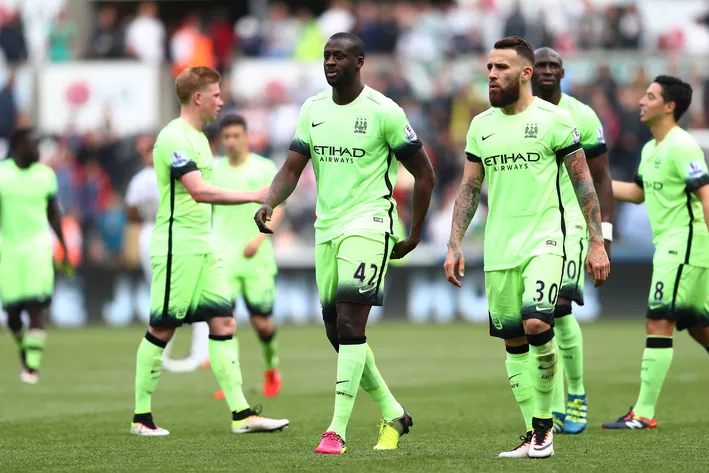Antonio Conte’s 3-4-2-1 formation has completely disoriented the Premier League. Since switching systems after the 3-0 defeat to Arsenal, Chelsea have won seven consecutive league games and inspired five other teams to give it a go. Spurs, Man City, West Ham, Watford, and Everton have copied Conte’s tactics, but none of have replicated its effectiveness. So far, Chelsea have been simply unstoppable.
If there is one man who can find the solution to Chelsea’s tactical conundrum it is Pep Guardiola. He is, along with Conte, one of the most fastidious and reactive coaches in world football; Guardiola will have spent weeks working out exactly how to nullify Eden Hazard and Pedro.
As revealed in Marti Perarnau’s book Pep Confidential, Guardiola spends the early parts of the season trialling various formations and strategies, only to immediately put them to one side so that his squad can build a repertoire to be called upon at a later date. With this in mind, here are the main three tactical models that Guardiola has to choose from this weekend.
1) Use inverted full-backs in a 4-1-4-1 formation
For the first few matches of the season Guardiola surprised the English press by using Backary Sagna and Gael Clichy as inverted full-backs, with both players moving into central midfield during sustained periods of Man City possession. This in turn allowed both Kevin de Bruyne and David Silva to drift up and down the two half-spaces without City looking light in central midfield.
We have not seen this tactic feature since August, and now would be the perfect time to bring it back. The most confusing aspect of Conte’s 3-4-2-1 is the use of dual playmakers, with Hazard and Pedro both floating behind Diego Costa. Since Victor Moses and Marcos Alonso are so effective out wide, no team has yet found a way to stifle Chelsea’s attacking midfielders without leaving themselves exposed on the flanks. Inverted full-backs might just be the answer.
Sagna and Clichy could be instructed to closely man-mark Pedro and Hazard, following them around the pitch wherever these two choose to play. This would mean they act like inverted full-backs through the middle should Hazard and Pedro play centrally (allowing De Bruyne and Silva to stay high, which would limit how many Chelsea players can afford to pour forward), or retain their usual position on the flanks should the Chelsea pair drift wide. The only potential downside to this system is that City could find themselves over-exposed on the wings, leaving Moses and Alonso to attack from deep.
2) Match Conte’s formation with a 3-4-2-1

City only mimicked Chelsea’s system once in the league this season, a 1-1 draw with Everton in which the hosts were completely dominant (73% possession, 19 shots on goal). This formation make a lot of sense given the type of players at Guardiola’s disposal. De Bruyne and Silva can both excel as floating playmakers similar to Pedro and Hazard, Ilkay Gundogan and Fernandinho possess the energy needed to control midfield as a duo, and Raheem Sterling and Leroy Sane offer penetration out wide when instructed to attack from deep.
The only other team to attempt to stop Chelsea using a like-for-like system was Everton, who were emphatically beaten 5-0. Ronald Koeman’s side didn’t appear to understand their roles and consistently left enormous pockets of space either side of the three centre-backs for Hazard and Pedro to roam into. City would surely be more cohesive, and with Fernandinho at the base of midfield will be considerably more energetic than Everton were.
Perhaps the biggest advantage of using a 3-4-2-1 is that it would allow Guardiola to leave Yaya Toure – a defensive liability – in the side. The Ivorian has been excellent since his return, and his positional laziness would not be a problem on Saturday should he be given a Hazard-esque free-role. Perhaps the best way to stop Chelsea’s varied attack is to simply man-mark each and every one of them.
Of course, man-for-man systems haven’t always worked out for Pep. His Bayern Munich team were famously beaten 3-0 by Barcelona when he tried to stifle MSN with a three-v-three approach at the back. Matching Chelsea’s formation is a risky option, but it could prove to be a master-stroke.
3) Use a double pivote of Fernando and Fernandinho in a 4-2-3-1

Fernando and Fernandinho have never looked comfortable as defensive midfield partners, something Guardiola discovered the hard way when his team lost 4-0 to Barcelona earlier this season. An important aspect of all Guardiola systems is that 15 passes are made before the team reach the penalty area in order to ensure that the team move up as a unit. Fernando is simply too flat and static to help achieve this.
However, Guardiola may be willing to sacrifice some of his usual control if he feels that the two Brazilians can tackle Pedro and Hazard out of the game. A 4-2-3-1 systems would require a more rigid approach moving forward, and probably means Toure will have to make way. On paper, this third option is the most obvious and would certainly be the most likely choice for most Premier League managers.
But in reality it is his weakest option; Conte has proved time and time again this season that a 3-4-2-1 is perfect at exploiting the inherent flaws of a 4-2-3-1; Guardiola should have something considerably more sophisticated up his sleeve.
Whatever his choices and whatever the outcome, get ready for one of the most fascinating tactical battles of the Premier League era.















